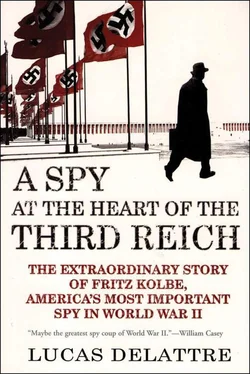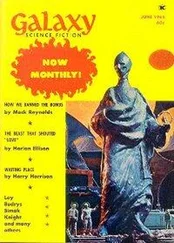“Mr. Douglas, Mayer’s assistant”: Morgan, “The Spy the Nazis Missed.”
“Dulles considered honest determination”: Unpublished, untitled document of 1954 in the personal archives of Allen Dulles. Allen W. Dulles Papers.
out of the envelope: How many documents were there in this first “delivery” from Fritz Kolbe? The figure of 186 cables is commonly put forward. Correspondence between Allen Dulles and Gerald Mayer, Allen W. Dulles Papers. But in an unpublished and undated memorandum, Allen Dulles speaks of only “20 copies of documents.” Allen Dulles/Fritz Kolbe correspondence, Allen W. Dulles Papers.
State Secretary Martin Luther: Martin Luther, Fritz Kolbe’s former superior, tried to provoke Ribbentrop’s fall in early February 1943. The “coup” just failed, and Martin Luther was arrested and sent to the concentration camp of Sachsenhausen. Behind Luther was probably Walter Schellenberg, Himmler’s chief of foreign intelligence, who had been trying to initiate negotiations with the Allies since the summer of 1942 and wanted to take over the reins of German foreign policy himself. For Schellenberg and Himmler, Ribbentrop remained the man of the Nazi-Soviet pact, in short the “friend of Moscow.” He was known to be opposed to any separate peace with the West, and his hatred for England was boundless.
“meters to the north”: Kappa message of August 26, 1943, National Archives. See also memorandum of August 19, 1943, OSS Bern, National Archives.
on August 7, 1943: On the August 7 Cairo cable, see Kappa message of August 25, 1943, National Archives.
out of his sleeve: “He had information that literally came out of his sleeve.” Biographical document by Gerald Mayer and Fritz Kolbe.
“tungsten to the Germans”: Memorandum of August 20, 1943, OSS Bern, National Archives. Tungsten, a metal that serves to harden steel, is indispensable for the arms industry.
“for days on end”: Memorandum of August 19, 1943, OSS Bern, National Archives.
minister of aeronautic production: Ibid.
in the Irish capital: Ireland had declared its neutrality in 1939. Berlin, which supported the Irish independence forces, wished to use the island as a base for observation and clandestine operations against England. The Reich had parachuted several secret agents in 1940, including Hermann Görtz. The United States vigorously protested to Eamon de Valera, head of the Irish government, against the presence of a clandestine German transmitter in Dublin, which was finally seized and neutralized during the winter of 1943–44. See Kappa message of April 12, 1944 and Boston documents nos. 12 and 124, National Archives. See also Enno Stephan, Spies in Ireland, tr. Arthur Davidson (Harrisburg: Stackpole, 1965).
ships in the southern oceans: On Lourenço Marques, see Kappa message of August 26, 1943, National Archives. A few months later, Fritz Kolbe provided information making it possible to trap Leopold Wertz, the German consul in Lourenço Marques: “Dr. Wertz has a weakness for women.” Kappa message of October 22, 1943.
“and original cipher results”: Memorandum of August 19, 1943 OSS Bern, National Archives.
to talk about himself: Portrait of Fritz Kolbe, August 19, 1943, OSS Bern, National Archives.
serve as a guarantee: Biographical document by Gerald Mayer and Fritz Kolbe.
“reimbursement of modest expenses”: “George answered that he would refuse any money for his collaboration, as he was driven by the conviction that only by helping now the Americans, Germany would merit a backing by the U.S., which tomorrow would prove necessary against the Russian threat.” Kocherthaler, “The Background of the George Story.”
“joke?” they both said: Morgan, “The Spy the Nazis Missed.”
Fritz felt “deep satisfaction”: Biographical document by Gerald Mayer and Fritz Kolbe.
Fritsch (“nicknamed ‘little rabbit’”:Häschen in German.
“just sense of reality”: Fritz Kolbe’s mother was opposed to the Nazis. In the early 1930s, she had moved out of her Berlin apartment because its windows overlooked an SA barracks and she could not bear the sight of the paramilitary uniforms. Anecdote recounted by Peter Kolbe, Sydney, November 2001; also in Morgan, “The Spy the Nazis Missed.”
“still a good brother”: Hans was an electronic engineer employed by the Loewe firm in Berlin and was not a member of the Nazi Party. Biographical document by Gerald Mayer and Fritz Kolbe.
“the last few years”: Manuscript will (dated August 19, 1943) and typewritten transcript, personal archives of Fritz Kolbe, Peter Kolbe collection, Sydney.
eight in the morning: Memorandum of August 28, 1943, Gerry Mayer and Allen Dulles, National Archives.
“also a lukewarm Nazi”: Memorandum of August 20, 1943, OSS Bern, National Archives.
two hundred Swiss francs: Biographical document by Gerald Mayer and Fritz Kolbe. The sum of two hundred Swiss francs was rather large, considering that the monthly salary of a high school teacher was seven hundred Swiss francs during the war. Source: Antoine Bosshard, Lausanne.
feeling of great success: “He felt the same exhilarating sensation he remembered having when he made his first successful ski jump after long and careful practice.” Morgan, “The Spy the Nazis Missed.”
he asked himself anxiously: Biographical document by Gerald Mayer and Fritz Kolbe.
“roasting in the sun”: Words from the anthem of the Germans of the “Südwest,” the “Südwesterlied.” Source: Peter Kolbe.
X-2 of the OSS: “The only element of OSS known to me to have had access to ULTRA on a continuing basis was the London office of X-2, the OSS counterespionage section in England. Although General Donovan was ‘indoctrinated’—the term for having been briefed and granted access to the ULTRA material—he was rarely in a position to follow it on a regular basis. To my knowledge James Murphy, chief of X-2, was the only OSS officer based in Washington who was indoctrinated and fully informed. It was his responsibility to keep General Donovan briefed on the most important ULTRA data.” Helms, A Look Over My Shoulder, p. 37.
name is a mystery: “Nobody remembered later just how the name George Wood was invented.” Morgan, “The Spy the Nazis Missed.”
being better than one: In the internal nomenclature of the OSS, Allen Dulles was number 110. He was also called “Burns.”
description of the man: Portrait of Fritz Kolbe, August 19, 1943, OSS Bern, National Archives.
Secret Intelligence Service (SIS): The Secret Intelligence Service (SIS), or MI6 (for Military Intelligence 6), had been headed since 1939 by Lieutenant-Colonel Stewart Menzies. It was subdivided into ten sections, including section V, which specialized in counterespionage.
assessment of the file: The note from Dansey to David Bruce was dated August 25, 1943, only five days after Fritz’s return to Berlin. Everything had gone very quickly. Source: National Archives.
Читать дальше











